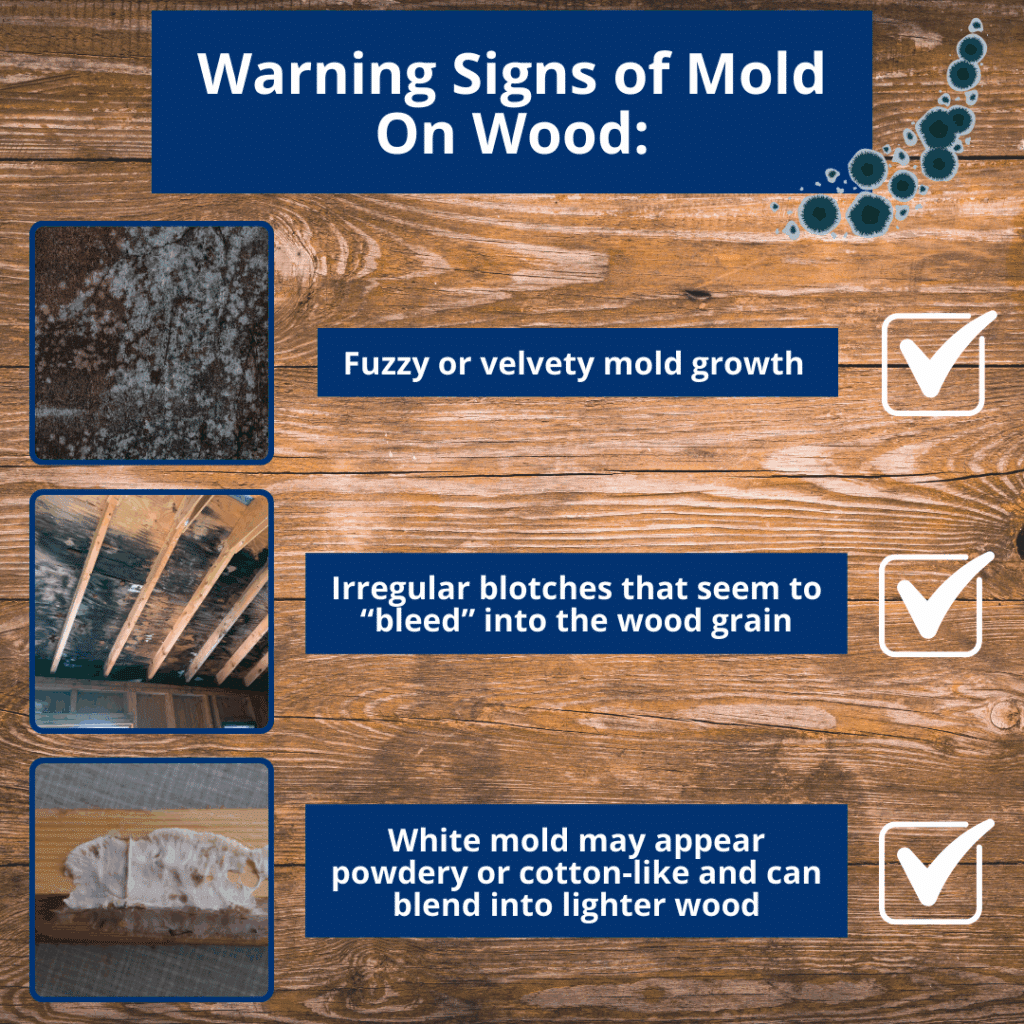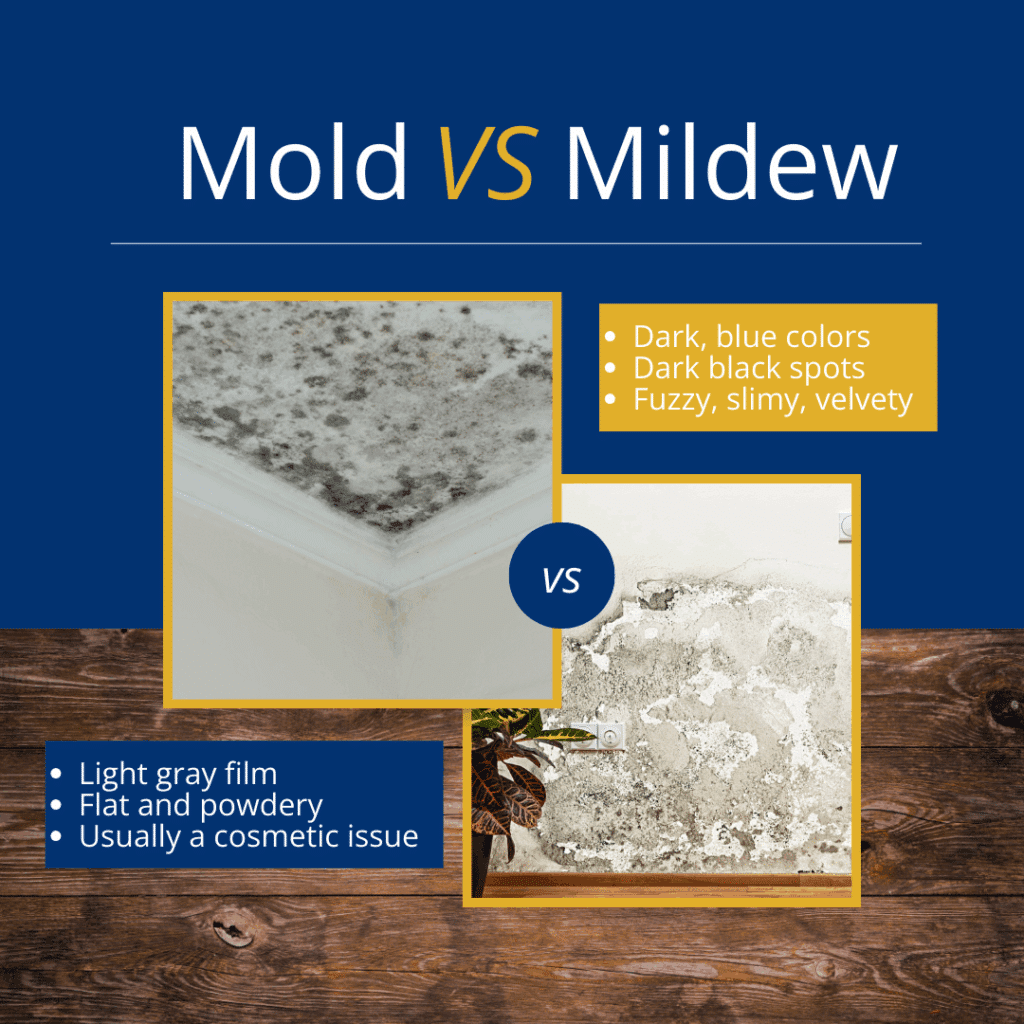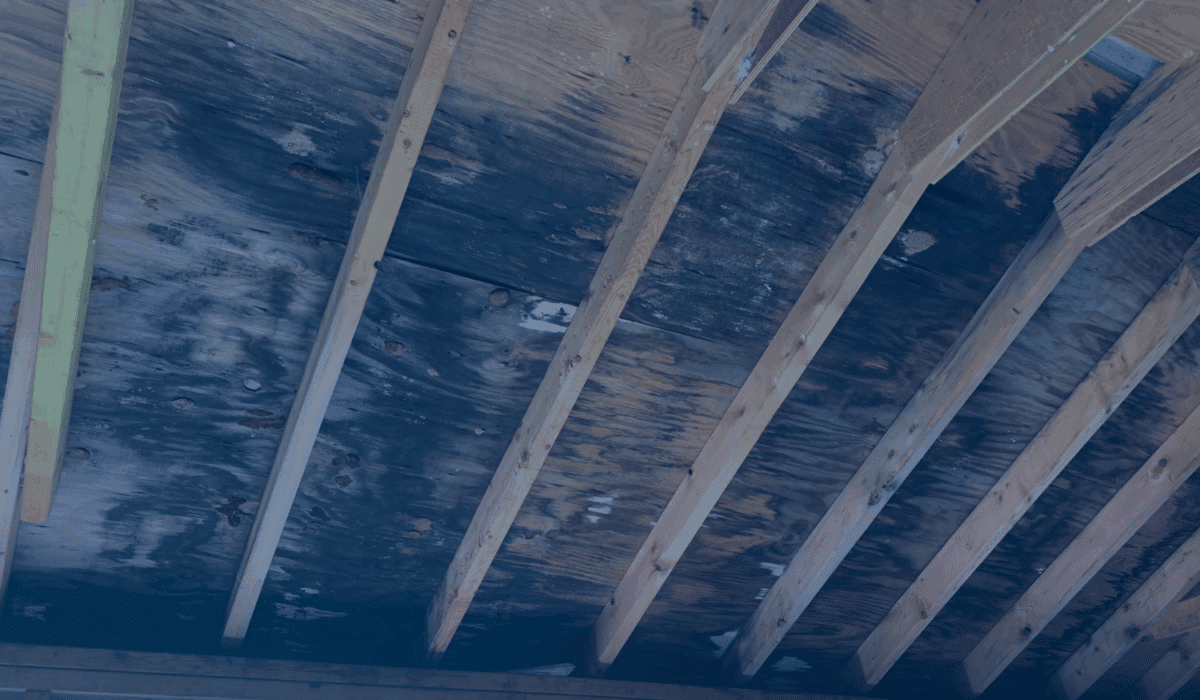What does mold look like on wood? It can appear as black, green, white, or even blue patches, often fuzzy, slimy, or powdery in texture. Mold may grow in spots, streaks, or large blotches, and these changes in color and texture are usually signs of excess moisture that shouldn’t be ignored.
How to Recognize Mold on Wood
Mold can grow on almost any wooden surface or foundation in your home if the conditions are right. Spotting mold early can prevent both structural damage and health concerns. Mold often changes the way wood looks and feels. These changes usually happen in three main ways:
- color shifts
- texture changes
- distinct growth patterns
Knowing the signs will help you act fast before the damage spreads.

Common Color Changes
Mold comes in many colors depending on the species, moisture level, and age of the growth. Color can be an important clue, but it is not a guarantee of the type or toxicity of mold.
- Black or dark green patches: These are the most recognized and are often linked to molds like Stachybotrys chartarum (black mold) or Cladosporium. These molds can thrive on damp wood for long periods and may indicate a significant moisture problem.
- Olive or light green areas: These often have a fuzzy or velvety look. Species like Cladosporium and Aspergillus are common culprits and can grow in lower light conditions, such as inside cabinets or along baseboards.
- White mold: Appears powdery, cotton-like, or fluffy. It can be harder to notice on unfinished or light-colored wood because it blends in. White mold often indicates Penicillium or Trichoderma, which can grow quickly in humid rooms like basements or attics.
- Blue, orange, or brown spots: While less common, these colors can occur with certain Aureobasidium or Chaetomium molds. In some cases, blue or brown discoloration may also be “blue stain” from fungal activity in the wood before it was installed, but active mold will typically feel different to the touch and may spread.
Texture Clues
Texture changes can help confirm whether you are dealing with mold and give hints about how advanced the growth is.
- Fuzzy or velvety: Indicates active spore production and growth, often from molds like Penicillium or Aspergillus. This texture traps dust and can release spores easily into the air when disturbed.
- Slimy or wet-looking: Common in molds that grow in constantly damp or waterlogged areas, such as Stachybotrys. The slime layer helps these molds retain moisture and can make cleaning more difficult.
- Powdery or crusty: This can be early-stage mold growth or mildew. It may brush off easily, but if the underlying wood is still damp, the growth will return quickly.
Growth Patterns
Mold growth on wood often follows patterns that are different from stains, dirt, or natural discoloration.
- Circular spots that cluster together: Mold colonies often start as small circles. Over time, these spots merge, forming larger irregular shapes.
- Irregular blotches that “bleed” into the wood grain: This effect happens when mold hyphae (root-like structures) penetrate into the wood fibers, causing staining that can be difficult to remove completely.
- Discoloration that does not fade when the wood dries: Water stains may lighten over time as the wood dries, but mold stains remain or even darken, especially if the moisture problem persists.
In many cases, a combination of these clues will appear together, such as dark green fuzzy patches spreading in circular clusters across a damp floorboard. Recognizing these signs early allows you to address the source of moisture and remove the mold before it spreads further.
What Causes Mold to Grow on Wood
Mold needs three things to grow: moisture, a food source, and the right temperature. Wood is an organic material, making it a perfect food source once moisture is present.
Most Common Causes:
- High indoor humidity from daily activities like cooking, showering, or drying clothes indoors
- Leaks from roofs, plumbing, or appliances
- Poor ventilation in bathrooms, kitchens, and basements
- Wood stored in damp or shaded areas such as garages or crawl spaces
Here in Georgia, our warm and humid climate creates ideal mold-growing conditions. Homes without proper ventilation or moisture control are at even higher risk.
Common Types of Mold Found on Wood
While the only way to confirm the exact mold type is through lab testing, here are some of the most common molds that affect wood and their typical appearance:
- Black mold (Stachybotrys) – Dark black or greenish-black, slimy texture, thrives in areas with long-term water damage.
- Cladosporium – Olive-green or brown, suede-like texture, often found in closets, cabinets, or behind furniture.
- Aspergillus – Cottony texture in blue-green or yellow-green shades, often in damp, dusty areas.
- Penicillium – Powdery blue, green, or pink patches that can spread quickly.
- White mold – Powdery or fuzzy, blends in with unfinished or light-colored wood.
Mold vs. Mildew on Wood
Mildew is actually a type of mold, but it grows differently. Mold on wood often appears in darker colors like black, green, or even blue, and it can feel fuzzy, slimy, or velvety. It also tends to grow into the wood, which can weaken the material and cause health concerns.
Mildew, on the other hand, usually shows up as a white or light gray film that stays on the surface. It’s flat and powdery and generally causes only cosmetic issues if caught early. The main difference is that mold can damage both the wood and your health, while mildew is easier to clean and less destructive.

Other Signs You May Have Mold on Wood
Sometimes mold is not easy to spot, but these clues can help:
- A musty, earthy smell that doesn’t go away
- Discoloration that spreads over time
- Warped or softened wood
- Regrowth after cleaning, especially if moisture problems remain
How to Safely Clean Small Areas of Mold on Wood
According to the United States Environmental Protection Agency (EPA), if the moldy area is less than 3 feet by 3 feet, you can usually clean it yourself.
Safety First:
- Wear gloves, safety glasses, and an N95 mask.
- Keep the area well-ventilated.
Steps:
- Stop the moisture source before cleaning, such as fixing leaks or improving airflow.
- Clean the surface with mild detergent and warm water, or a vinegar and water solution.
- Rinse lightly and dry completely.
- Improve ventilation to prevent regrowth.
What Not to Do:
- Do not use bleach on porous wood. It can damage the surface and may not kill mold roots.
- Avoid simply painting over mold. This traps moisture and can cause the problem to spread underneath.
How to Prevent Mold from Returning
Prevention is key once the mold is gone.
- Keep indoor humidity below 60 percent (ideally 30–50 percent).
- Run exhaust fans when cooking, bathing, or doing laundry.
- Fix leaks right away.
- Use a dehumidifier in damp areas like basements or crawl spaces.
- Inspect wooden furniture and stored items regularly.
Related Questions About Mold on Wood
Can mold on wood make you sick?
Yes. Mold spores can cause allergic reactions, asthma flare-ups, and other respiratory symptoms. Some mold types can produce toxins.
Does mold always damage the wood?
Not always. Early cleaning and drying can prevent permanent damage, but advanced mold can weaken the wood’s structure.
Will painting over mold stop it from growing?
No. Painting over mold seals in moisture and can make the growth worse. The mold must be removed before painting.
Conclusion: Protecting Your Home from Mold
Knowing what mold looks like on wood can help you catch it early and prevent costly damage. Quick action, moisture control, and routine checks are the best defenses for your home.
If you suspect mold in your home or want peace of mind, Edifice Inspections can help. Our detailed home inspections can uncover hidden moisture problems and potential mold risks before they become serious issues.
Schedule your inspection today to keep your home safe and sound.


4 Comments
Comments are closed.